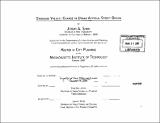Standard values : change in urban arterial street design
Author(s)
Shaw, Jeremy A. (Jeremy Andrew)
DownloadFull printable version (20.60Mb)
Alternative title
Change in urban arterial street design
Other Contributors
Massachusetts Institute of Technology. Dept. of Urban Studies and Planning.
Advisor
Eran Ben-Joseph.
Terms of use
Metadata
Show full item recordAbstract
The highway-building industry and highway governance was born in the minds of progressive engineers bent on ushering in a new era of efficiency, progress and modern transport. Governance and standards in California heavily influenced other state highway organizations. This research traces the evolution of values in urban arterial street design and standards in the United States and California. For nearly 100 years, the design criteria of geometric street standards have been based on increasing automobility, as if without end. Since the 1960s, liability concerns have guided significant changes in design standards, mostly based on passive driver safety design. Since then, legal action has given rise to bicycle and ADA-based design standards. Right-of-way constraints have lowered minimum widths and "flexibility" has impacted design philosophy and process. However, these latter forces are not driving fundamental or enforceable change to design standards. Change to mandatory standards remains driven by automobility and liability concerns. Despite conventional standards, unconventional values manifest in the design and planning of streets. (cont.) Using the case of El Camino Real in Palo Alto, this research explores the difficulty of implementing unconventional street design through the process of changing standards. It then draws on the case of Santa Monica Boulevard in Los Angeles to demonstrate that individual projects under local jurisdiction are more likely to impact the design of streets. Further research is warranted on state highway relinquishment, the philosophy of context-sensitive design, and methods of selecting design speed.
Description
Thesis (M.C.P.)--Massachusetts Institute of Technology, Dept. of Urban Studies and Planning, 2007. Includes bibliographical references (p. 84-91).
Date issued
2007Department
Massachusetts Institute of Technology. Department of Urban Studies and PlanningPublisher
Massachusetts Institute of Technology
Keywords
Urban Studies and Planning.